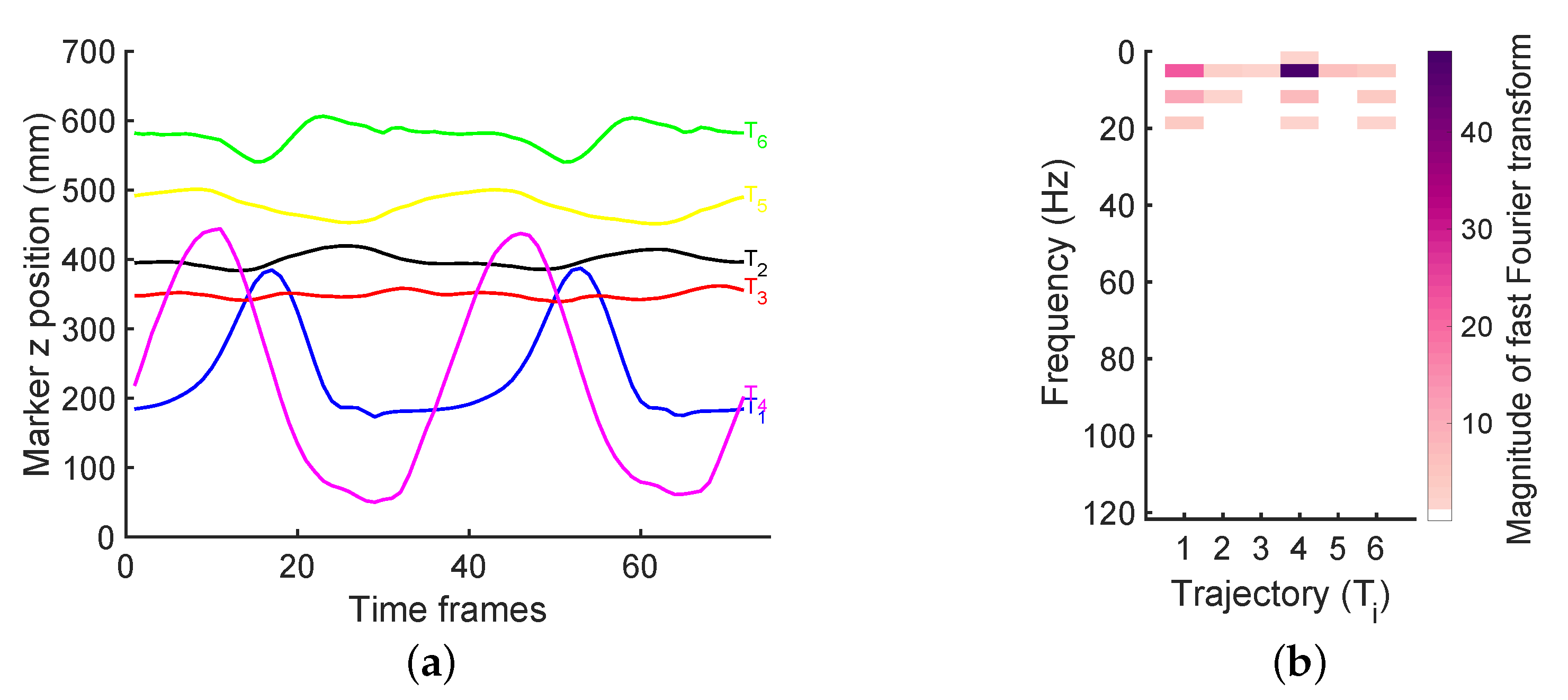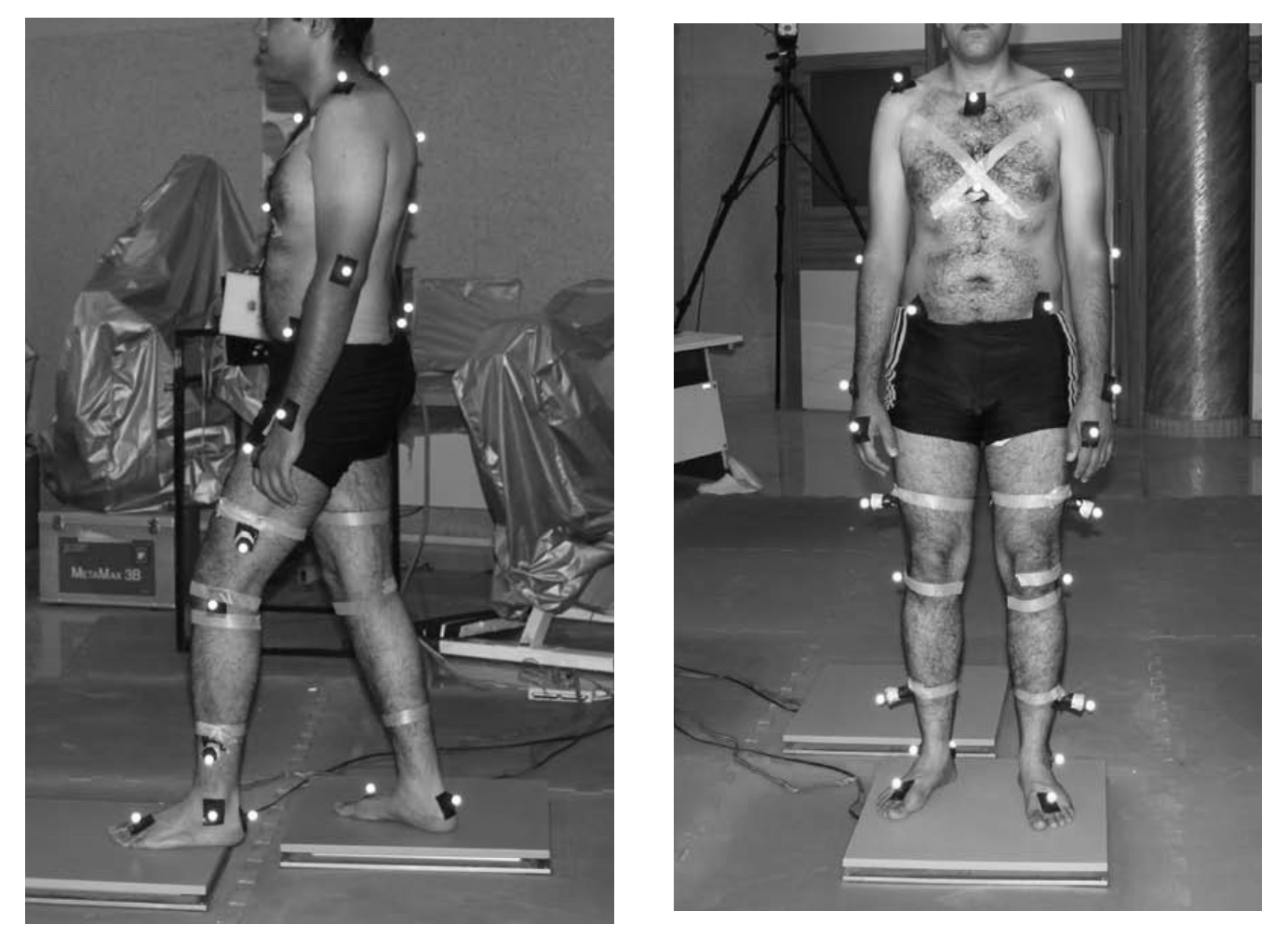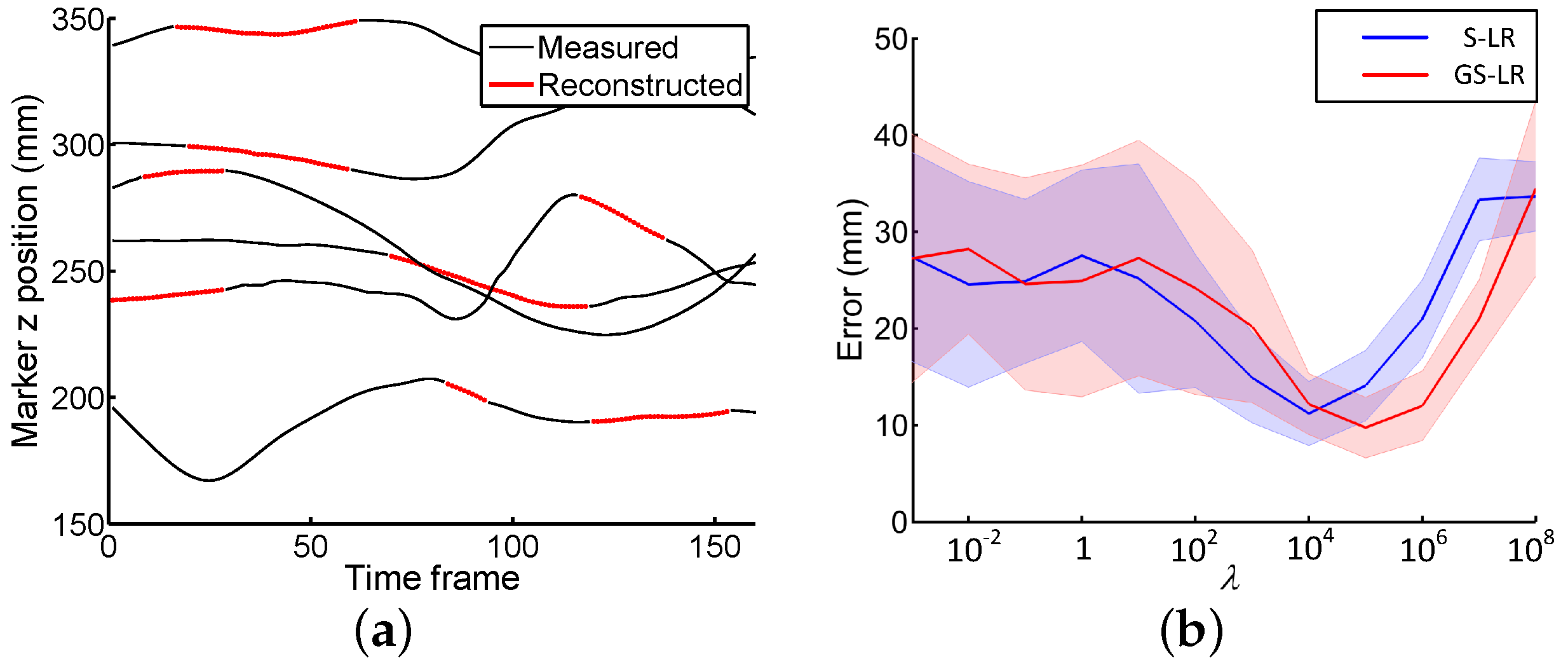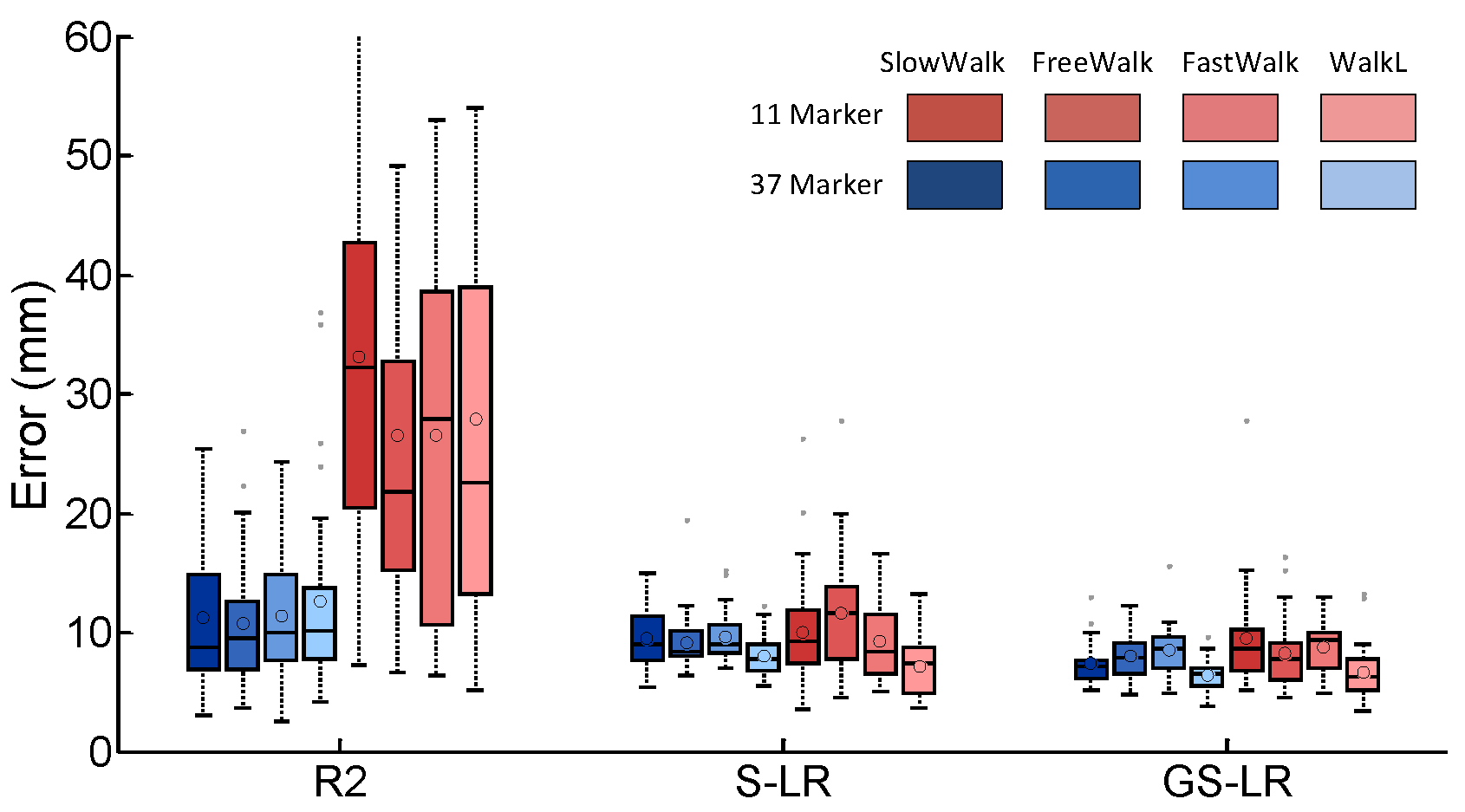Low-Rank and Sparse Recovery of Human Gait Data
Abstract
1. Introduction
2. Materials and Methods
2.1. Problem Formulation
2.2. Optimization Strategy
2.3. Experiments and Analysis
2.3.1. Data Acquisition
2.3.2. Data Analysis
3. Results
4. Discussion
4.1. Comparison of the Two Proposed Approaches for Human Gait Data Recovery
4.2. Limitations of This Study
5. Conclusions
Author Contributions
Funding
Conflicts of Interest
References
- Siddhartha, B.; Debanjan, K.; Jan, P.; Chinmoy, K.; Kalpana, S. Hybrid Machine Intelligence for Medical Image Analysis; Springer: Singapore, 2020. [Google Scholar]
- Hegde, N.; Bries, M.; Sazonov, E. A Comparative Review of Footwear-Based Wearable Systems. Electronics 2016, 5, 48. [Google Scholar] [CrossRef]
- Rucco, R.; Sorriso, A.; Liparoti, M.; Ferraioli, G.; Sorrentino, P.; Ambrosanio, M.; Baselice, F. Type and Location of Wearable Sensors for Monitoring Falls during Static and Dynamic Tasks in Healthy Elderly: A Review. Sensors (Basel, Switzerland) 2018, 18, 1613. [Google Scholar] [CrossRef]
- Ren, L.; Peng, Y. Research of Fall Detection and Fall Prevention Technologies: A Systematic Review. IEEE Access 2019, 7, 77702–77722. [Google Scholar] [CrossRef]
- Prakash, C.; Kumar, R.; Mittal, N. Recent developments in human gait research: Parameters, approaches, applications, machine learning techniques, datasets and challenges. Artif. Intell. Rev. 2018, 49, 1–40. [Google Scholar]
- Vicon Motion System. VICON. Available online: https://www.vicon.com (accessed on 8 August 2020).
- Frenken, T.; Lohmann, O.; Frenken, M.; Steen, E.E.; Hein, A. Performing gait analysis within the timed up & go assessment test: Comparison of aTUG to a marker-based tracking system. Inform. Health Soc. Care 2014, 39, 232–248. [Google Scholar] [CrossRef]
- TarniŢă, D. Wearable sensors used for human gait analysis. Rom. J. Morphol. Embryol. 2016, 57, 373–382. [Google Scholar]
- Cappozzo, A.; Della Croce, U.; Leardini, A.; Chiari, L. Human movement analysis using stereophotogrammetry: Part 1: Theoretical background. Gait Posture 2005, 21, 186–196. [Google Scholar]
- Sutherland, D.H. The evolution of clinical gait analysis: Part II Kinematics. Gait Posture 2002, 16, 159–179. [Google Scholar] [CrossRef]
- Saboune, J.; Charpillet, F. Markerless Human Motion Capture for Gait Analysis. arXiv 2005, arXiv:abs/cs/0510063. [Google Scholar]
- Rodrigues, T.; Salgado, D.; Catháin, C.; Connor, N. Human gait assessment using a 3D marker-less multimodal motion capture system. Multimed. Tools Appl. 2019, 79, 2629–2651. [Google Scholar] [CrossRef]
- Verlekar, T.T.; Soares, L.D.; Correia, P.L. Automatic Classification of Gait Impairments Using a Markerless 2D Video-Based System. Sensors 2018, 18, 2743. [Google Scholar] [CrossRef] [PubMed]
- Nguyen, T.N.; Huynh, H.H.; Meunier, J. Extracting Silhouette-Based Characteristics for Human Gait Analysis Using One Camera. In Proceedings of the Fifth Symposium on Information and Communication Technology (SoICT), Association for Computing Machinery, Hanoi, Viet Nam, 4–5 December 2014; ACM: New York, NY, USA, 2014; pp. 171–177. [Google Scholar] [CrossRef]
- Ceseracciu, E.; Sawacha, Z.; Cobelli, C. Comparison of Markerless and Marker-Based Motion Capture Technologies through Simultaneous Data Collection during Gait: Proof of Concept. PLoS ONE 2014, 9, e087640. [Google Scholar] [CrossRef] [PubMed]
- Chiari, L.; Della Croce, U.; Leardini, A.; Cappozzo, A. Human movement analysis using stereophotogrammetry: Part 2: Instrumental errors. Gait Posture 2005, 21, 197–211. [Google Scholar] [CrossRef] [PubMed]
- Coburn, J.; Crisco, J.J. Interpolating three-dimensional kinematic data using quaternion splines and hermite curves. J. Biomech. Eng. 2005, 127, 311–317. [Google Scholar] [CrossRef]
- Wold, S. Spline functions in data analysis. Technometrics 1974, 16, 1–11. [Google Scholar] [CrossRef]
- Howarth, S.J.; Callaghan, J.P. Quantitative assessment of the accuracy for three interpolation techniques in kinematic analysis of human movement. Comput. Methods Biomech. Biomed. Eng. 2010, 13, 847–855. [Google Scholar] [CrossRef]
- Wu, Q.; Boulanger, P. Real-time estimation of missing markers for reconstruction of human motion. In Proceedings of the XIII Symposium on the Virtual Reality (SVR), Uberlandia, Brazil, 23–26 May 2011; IEEE: New York, NY, USA, 2011; pp. 161–168. [Google Scholar] [CrossRef]
- Aristidou, A.; Lasenby, J. Real-time marker prediction and CoR estimation in optical motion capture. Vis. Comput. 2013, 29, 7–26. [Google Scholar] [CrossRef]
- Dorfmüller-Ulhaas, K. Robust Optical User Motion Tracking Using a Kalman Filter. In Proceedings of the 10th ACM Symposium on Virtual Reality Software and Technology, Osaka, Japan, 1–3 October 2003; ACM: New York, NY, USA, 2003; pp. 1–10. [Google Scholar]
- Liu, G.; McMillan, L. Estimation of Missing Markers in Human Motion Capture. Vis. Comput. 2006, 22, 721–728. [Google Scholar] [CrossRef]
- Li, L.; McCann, J.; Pollard, N.S.; Faloutsos, C. BoLeRO: A principled technique for including bone length constraints in motion capture occlusion filling. In Proceedings of the 2010 ACM SIGGRAPH/Eurographics Symposium on Computer Animation (SCA’10), Madrid, Spain, 2–4 July 2010; ACM: New York, NY, USA, 2010; pp. 179–188. [Google Scholar] [CrossRef]
- Feng, Y.; Xiao, J.; Zhuang, Y.; Yang, X.; Zhang, J.J.; Song, R. Exploiting temporal stability and low-rank structure for motion capture data refinement. Inf. Sci. 2014, 277, 777–793. [Google Scholar] [CrossRef]
- Mall, U.; Lal, G.; Chaudhuri, S.; Chaudhuri, P. A Deep Recurrent Framework for Cleaning Motion Capture Data. arXiv 2017, arXiv:abs/1712.03380. [Google Scholar]
- Burke, M.; Lasenby, J. Estimating missing marker positions using low dimensional Kalman smoothing. J. Biomech. 2016, 49, 1854–1858. [Google Scholar] [CrossRef] [PubMed]
- Baumann, J.; Krüger, B.; Zinke, A.; Weber, A. Data-Driven Completion of Motion Capture Data. In Proceedings of the 8th Workshop on Virtual Reality Interactions and Physical Simulations (VRIPHYS), Lyon, France, 5–6 December 2011; The Eurographics Association: Geneva, Switzerland, 2011; pp. 111–118. [Google Scholar] [CrossRef]
- Federolf, P.; Boyer, K.; Andriacchi, T. Application of principal component analysis in clinical gait research: Identification of systematic differences between healthy and medial knee-osteoarthritic gait. J. Biomech. 2013, 46, 2173–2178. [Google Scholar] [CrossRef] [PubMed]
- Gløersen, Ø.; Federolf, p. Predicting Missing Marker Trajectories in Human Motion Data Using Marker Intercorrelations. PLoS ONE 2016, 11, e0152616. [Google Scholar]
- Federolf, P.A. A novel approach to solve the “missing marker problem” in marker-based motion analysis that exploits the segment coordination patterns in multi-limb motion data. PLoS ONE 2013, 8, e078689. [Google Scholar] [CrossRef]
- Wen, F.; Chu, L.; Liu, P.; Qiu, R.C. A Survey on Nonconvex Regularization-Based Sparse and Low-Rank Recovery in Signal Processing, Statistics, and Machine Learning. IEEE Access 2018, 6, 69883–69906. [Google Scholar] [CrossRef]
- Ji, H.; Liu, C.; Shen, Z.; Xu, Y. Robust video denoising using low rank matrix completion. In Proceedings of the 2010 IEEE Computer Society Conference on Computer Vision and Pattern Recognition, San Francisco, CA, USA, 13–18 June 2010; pp. 1791–1798. [Google Scholar] [CrossRef]
- Ji, H.; Huang, S.; Shen, Z.; Xu, Y. Robust video restoration by joint sparse and low rank matrix approximation. Siam J. Imaging Sci. 2011, 4, 1122–1142. [Google Scholar] [CrossRef]
- Ma, R.; Barzigar, N.; Roozgard, A.; Cheng, S. Decomposition approach for low-rank matrix completion and its applications. IEEE Trans. Signal Process. 2014, 62, 1671–1683. [Google Scholar] [CrossRef]
- Lai, R.Y.Q.; Yuen, P.C.; Lee, K.K.W. Motion Capture Data Completion and Denoising by Singular Value Thresholding. In Eurographics 2011–Short Papers; Avis, N., Lefebvre, S., Eds.; The Eurographics Association: Geneva, Switzerland, 2011. [Google Scholar] [CrossRef]
- Tan, C.; Hou, J.; Chau, L. Human motion capture data recovery using trajectory-based matrix completion. Electron. Lett. 2013, 49, 752–754. [Google Scholar] [CrossRef]
- Yang, J.; Guo, X.; Li, K.; Wang, M.; Lai, Y.; Wu, F. Spatio-Temporal Reconstruction for 3D Motion Recovery. IEEE Trans. Circuits Syst. Video Technol. 2019, 30, 1583–1596. [Google Scholar] [CrossRef]
- Liu, X.; Cheung, Y.M.; Peng, S.J.; Cui, Z.; Zhong, B.; Du, J.X. Automatic motion capture data denoising via filtered subspace clustering and low rank matrix approximation. Signal Process. 2014, 105, 350–362. [Google Scholar] [CrossRef]
- Wang, X.; Wang, F.; Chen, Y. Capturing Complex 3D Human Motions with Kernelized Low-Rank Representation from Monocular RGB Camera. Sensors 2017, 17, 2019. [Google Scholar] [CrossRef] [PubMed]
- Candès, E.J.; Li, X.; Ma, Y.; Wright, J. Robust Principal Component Analysis? J. ACM 2011, 58, 37. [Google Scholar] [CrossRef]
- Koltchinskii, V.; Lounici, K.; Tsybakov, A.B. Nuclear-norm penalization and optimal rates for noisy low-rank matrix completion. Ann. Stat. 2011, 39, 2302–2329. [Google Scholar] [CrossRef]
- Chen, C.; Huang, J. Compressive sensing MRI with wavelet tree sparsity. In Advances in Neural Information Processing Systems; The MIT Press: Cambridge, MA, USA, 2012; pp. 1115–1123. [Google Scholar]
- Lai, Z.; Qu, X.; Liu, Y.; Guo, D.; Ye, J.; Zhan, Z.; Chen, Z. Image reconstruction of compressed sensing MRI using graph-based redundant wavelet transform. Med Image Anal. 2016, 27, 93–104. [Google Scholar] [CrossRef] [PubMed]
- Bengio, S.; Pereira, F.; Singer, Y.; Strelow, D. Group sparse coding. In Advances in Neural Information Processing Systems; The MIT Press: Cambridge, MA, USA, 2009; pp. 82–89. [Google Scholar]
- Majumdar, A.; Ward, R.K. Exploiting rank deficiency and transform domain sparsity for MR image reconstruction. Magn. Reson. Imaging 2012, 30, 9–18. [Google Scholar] [CrossRef]
- Dong, W.; Shi, G.; Li, X. Nonlocal Image Restoration With Bilateral Variance Estimation: A Low-Rank Approach. IEEE Trans. Image Process. 2013, 22, 700–711. [Google Scholar] [CrossRef]
- Ke-yang, C.; Qirong, M.; Yong-zhao, Z. Pedestrian Detection Based on Sparse and Low-Rank Matrix Decomposition. Indones. J. Electr. Eng. Comput. Sci. 2014, 12, 1544–1550. [Google Scholar] [CrossRef]
- Otazo, R.; Candès, E.; Sodickson, D. Low-rank plus sparse matrix decomposition for accelerated dynamic MRI with separation of background and dynamic components. Magn. Reson. Med. 2015, 73, 1125–1136. [Google Scholar] [CrossRef] [PubMed]
- Yuan, Q.; Ng, M.; Shen, H.; Zhang, L.; Li, J. Miss data reconstruction in remote sensing images with a double weighted tensor low rank model. In Proceedings of the 2017 IEEE International Geoscience and Remote Sensing Symposium (IGARSS), Fort Worth, TX, USA, 23–28 July 2017; IEEE: New York, NY, USA, 2017; pp. 4036–4039. [Google Scholar] [CrossRef]
- Gotardo, P.F.U.; Martinez, A.M. Non-rigid structure from motion with complementary rank-3 spaces. CVPR 2011, 3065–3072. [Google Scholar] [CrossRef]
- Zhang, X.; Yang, Y.; Jia, H.; Zhou, H.; Jiao, L. Low-rank representation based action recognition. In Proceedings of the 2014 International Joint Conference on Neural Networks (IJCNN), Beijing, China, 6–11 July 2014; IEEE: New York, NY, USA, 2014; pp. 1812–1818. [Google Scholar] [CrossRef]
- Agudo, A.; Moreno-Noguer, F. DUST: Dual Union of Spatio-Temporal Subspaces for Monocular Multiple Object 3D Reconstruction. In Proceedings of the IEEE Conference on Computer Vision and Pattern Recognition (CVPR), Honolulu, HI, USA, 21–26 July 2017; IEEE: New York, NY, USA, 2017; pp. 1513–1521. [Google Scholar] [CrossRef]
- Wang, Z.; Feng, Y.; Liu, S.; Xiao, J.; Yang, X.; Zhang, J.J. A 3D human motion refinement method based on sparse motion bases selection. CASA 2016. [Google Scholar] [CrossRef]
- CHENG, S.; GU, S.; YE, M.; XIE, M. Action Recognition Using Low-Rank Sparse Representation. Ieice Trans. Inf. Syst. 2018, E101.D, 830–834. [Google Scholar] [CrossRef]
- Xia, G.; Sun, H.; Chen, B.; Liu, Q.; Feng, L.; Zhang, G.; Hang, R. Nonlinear Low-Rank Matrix Completion for Human Motion Recovery. IEEE Trans. Image Process. 2018, 27, 3011–3024. [Google Scholar] [CrossRef] [PubMed]
- Agudo, A.; Moreno-Noguer, F. Robust Spatio-Temporal Clustering and Reconstruction of Multiple Deformable Bodies. IEEE Trans. Pattern Anal. Mach. Intell. 2019, 41, 971–984. [Google Scholar] [CrossRef] [PubMed]
- Boyd, S.; Parikh, N.; Chu, E.; Peleato, B.; Eckstein, J. Distributed optimization and statistical learning via the alternating direction method of multipliers. Found. TrendsMach. Learn. 2011, 3, 1–122. [Google Scholar]
- Antonsson, E.K.; Mann, R.W. The frequency content of gait. J. Biomech. 1985, 18, 39–47. [Google Scholar] [CrossRef]
- Giakas, G.; Baltzopoulos, V. Time and frequency domain analysis of ground reaction forces during walking: An investigation of variability and symmetry. Gait Posture 1997, 5, 189–197. [Google Scholar] [CrossRef]
- Schneider, E.; Chao, E. Fourier analysis of ground reaction forces in normals and patients with knee joint disease. J. Biomech. 1983, 16, 591–601. [Google Scholar] [CrossRef]
- Matsaglia, G.; Styan, G.P.H. Equalities and Inequalities for Ranks of Matrices. Linear Multilinear Algebra 1974, 2, 269–292. [Google Scholar] [CrossRef]
- Cai, J.F.; Candès, E.J.; Shen, Z. A singular value thresholding algorithm for matrix completion. Siam J. Optim. 2010, 20, 1956–1982. [Google Scholar] [CrossRef]
- Jolliffe, I.T.; Cadima, J. Principal component analysis: A review and recent developments. Philos. Trans. R. Soc. Math. Phys. Eng. Sci. 2016, 374. [Google Scholar] [CrossRef]
- Daffertshofer, A.; Lamoth, C.J.C.; Meijer, O.G.; Beek, P.J. PCA in studying coordination and variability: A tutorial. Clin. Biomech. (Bristol, Avon) 2004, 19, 415–428. [Google Scholar] [CrossRef] [PubMed]
- Reid, S.M.; Graham, R.B.; Costigan, P.A. Differentiation of young and older adult stair climbing gait using principal component analysis. Gait Posture 2010, 31, 197–203. [Google Scholar] [CrossRef] [PubMed]
- Federolf, P.; Tecante, K.; Nigg, B. A holistic approach to study the temporal variability in gait. J. Biomech. 2012, 45, 1127–1132. [Google Scholar] [CrossRef] [PubMed]
- Gouelle, A.; Mégrot, F.; Presedo, A.; Husson, I.; Yelnik, A.; Penneçot, G.F. The Gait Variability Index: A new way to quantify fluctuation magnitude of spatiotemporal parameters during gait. Gait Posture 2013, 38, 461–465. [Google Scholar] [CrossRef]
- Maki, B.E. Gait changes in older adults: Predictors of falls or indicators of fear. J. Am. Geriatr. Soc. 1997, 45, 313–320. [Google Scholar] [CrossRef]




| Dataset | GS-LR vs. R2 | GS-LR vs. S-LR | ||
|---|---|---|---|---|
| 37 Markers | 11 Markers | 37 Markers | 11 Markers | |
| SlowWalk | 0.004 | <0.001 | <0.001 | 0.504 |
| FreeWalk | 0.022 | <0.001 | 0.034 | 0.001 |
| FastWalk | 0.026 | <0.001 | 0.019 | 0.688 |
| WalkL | <0.001 | <0.001 | <0.001 | 0.094 |
© 2020 by the authors. Licensee MDPI, Basel, Switzerland. This article is an open access article distributed under the terms and conditions of the Creative Commons Attribution (CC BY) license (http://creativecommons.org/licenses/by/4.0/).
Share and Cite
Kamali, K.; Akbari, A.A.; Desrosiers, C.; Akbarzadeh, A.; Otis, M.J.-D.; Ayena, J.C. Low-Rank and Sparse Recovery of Human Gait Data. Sensors 2020, 20, 4525. https://doi.org/10.3390/s20164525
Kamali K, Akbari AA, Desrosiers C, Akbarzadeh A, Otis MJ-D, Ayena JC. Low-Rank and Sparse Recovery of Human Gait Data. Sensors. 2020; 20(16):4525. https://doi.org/10.3390/s20164525
Chicago/Turabian StyleKamali, Kaveh, Ali Akbar Akbari, Christian Desrosiers, Alireza Akbarzadeh, Martin J.-D. Otis, and Johannes C. Ayena. 2020. "Low-Rank and Sparse Recovery of Human Gait Data" Sensors 20, no. 16: 4525. https://doi.org/10.3390/s20164525
APA StyleKamali, K., Akbari, A. A., Desrosiers, C., Akbarzadeh, A., Otis, M. J.-D., & Ayena, J. C. (2020). Low-Rank and Sparse Recovery of Human Gait Data. Sensors, 20(16), 4525. https://doi.org/10.3390/s20164525







